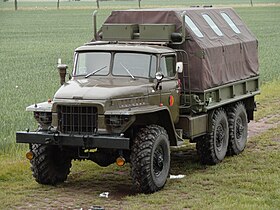Ural-375
Appearance
This article relies largely or entirely on a single source. (October 2018) |
| Ural-375, Ural-375D | |
|---|---|
 | |
| Overview | |
| Manufacturer | Ural Automobile Plant, Miass |
| Production | 1961–1993[1]
|
| Body and chassis | |
| Class | Truck |
| Powertrain | |
| Engine | 7.0L ZIL-375Ya V8 |
| Transmission | 5-speed manual + 2-speed transfer case |
| Dimensions | |
| Length | 7,350 mm (289.4 in) |
| Width | 2,960 mm (116.5 in) |
| Height | 2,980 mm (117.3 in) (with tent) |
| Curb weight | 8,400 kg (18,519 lb) |
| Chronology | |
| Predecessor | Ural-355M |
| Successor | Ural-4320 |
The Ural-375 is a general purpose 4.5 ton 6×6 truck produced at the Ural Automotive Plant in the Russian SFSR from 1961 to 1993. The Ural-375 replaced the ZIL-157 as the standard Soviet Army truck in 1979, and was replaced by the Ural-4320.
The Ural-375 was used, for example, as a platform for the BM-21 Grad rocket launcher, as a troop carrier, and as a supply carrier.
Models
[edit]

The Ural-375 comes in a variety of models (the list is not exhaustive):
- Ural-375, the base model. It has a canvas roof, and no steel cabin
- Ural-375A, a slightly longer model
- Ural-375D, the most produced 375; it has a proper all-steel cabin
- Ural-375E KET-L, a recovery vehicle equipped a front-mounted and a rear-mounted winch along with a jib crane.[2]
- Ural-375S, a 6×6 tractor
- Ural-377, a civilian 6×4 truck
- Ural-377S, a 6×4 tractor
- Ural-375DM, modernized version of the Ural-375D, built at least until 1991[1]
Specifications
[edit]
- Conventional cab, 3 seats
- Payload: 4,800 kg (10,580 lb)
- Max. permissible mass: 13,200 kg (29,100 lb)
- Suspension: live beam axles, leaf springs
- Engine: 130 kW (180 PS) (GOST) ZIL-375Ya 7.0-litre V8 petrol (carburetor) pushrod engine
- Gearbox: 5×2-speed gearbox
- Max. speed: 75 km/h (47 mph)
- Brakes: Pneumatic drum brakes
- Fording depth: 1500 mm (59 in)
- Dimensions: L×W×H = 7350 × 2690 × 2980 mm (289.4 × 105.9 × 117.3 in); includes tarpaulin
- Track width: 2000 mm (78.7 in)
- Turning circle: 22,000 mm (866 in)
- Ground Clearance: 400 mm (15.7 in)
- Tires: 360–510 mm (14–20 in), pressure 49–314 kPa (0.5–3.2 kgf/cm2)
- Fuel tank: 300 + 60 L (79 + 16 US gal)
- Fuel economy: 50–45 L/100 km (4.7–5.2 mpg‑US)
Users
[edit]This section needs additional citations for verification. (February 2024) |

 Angola
Angola Egypt
Egypt Ethiopia
Ethiopia Georgia
Georgia Hungary
Hungary Iran: Received Ural-375Ds during 1970s.
Iran: Received Ural-375Ds during 1970s. Namibia
Namibia North Korea
North Korea Poland: Only specialized variants in use.
Poland: Only specialized variants in use. Russia - 4000+ in active service over 10,000 in storage most in need of overhaul.
Russia - 4000+ in active service over 10,000 in storage most in need of overhaul. Serbia
Serbia Syria[3]
Syria[3] Transnistria[4]
Transnistria[4] Ukraine: Seen in use during the Russian invasion of Ukraine[5]
Ukraine: Seen in use during the Russian invasion of Ukraine[5] Vietnam[6]
Vietnam[6]
Former users
[edit] Afghanistan
Afghanistan East Germany: Passed onto Germany.
East Germany: Passed onto Germany. Iraq: All destroyed or retired since 2003.
Iraq: All destroyed or retired since 2003. Romania: All destroyed or retired, only one known in conservation in poor shape.
Romania: All destroyed or retired, only one known in conservation in poor shape. Soviet Union: Passed into successor states.
Soviet Union: Passed into successor states.
See also
[edit]References
[edit]- ^ a b Information about the Ural-375D, its history and the model range (russian)
- ^ Tanks and armored fighting vehicles : visual encyclopedia. New York, N.Y.: Chartwell Books. 2012. p. 342. ISBN 9780785829263. OCLC 785874088.
- ^ Mitzer, Stijn; Oliemans, Joost (23 November 2020). "Fighting Attrition: A Look Inside a Damascus Armour Repair Facility". Oryx. Retrieved 4 February 2024.
- ^ Mitzer, Stijn; Oliemans, Joost (30 November 2020). "The Victory Day Parade That Everyone Forgot". Oryx. Retrieved 4 February 2024.
- ^ Janovsky, Jakub; naalsio26; Aloha; Dan; Kemal; Black, Alexander. "Attack On Europe: Documenting Ukrainian Equipment Losses During The Russian Invasion Of Ukraine". Oryx. Retrieved 28 January 2024.
{{cite web}}: CS1 maint: numeric names: authors list (link) - ^ "Vietnam Has Developed a 105mm Self-Propelled Howitzer on a Ural-375D Chassis 20051531 | May 2015 Global Defense Security news UK | Defense Security global news industry army 2015 | Archive News year". www.armyrecognition.com. Retrieved 5 January 2021.
External links
[edit]Wikimedia Commons has media related to Ural-375.
